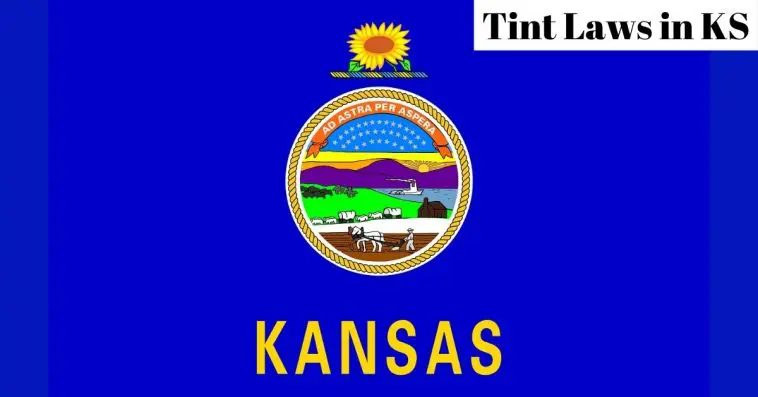Window tint can help reduce the light coming inside your vehicle. This is beneficial especially if you are living in a humid and hot place. However, certain regulations in the United States restrict window tint darkness.
This article will teach you the window tint laws you must follow whenever you are in Kansas.
TABLE OF CONTENTS
Are You Allowed To Have Tinted Windows And Windshield In Kansas?
Kansas State is one of the earliest states to enact the window tint law. The existing laws in the state is also one of the strictest when it comes to tinting car windows. Depending on the window you are tinting, you need to follow specific rules.
Aside from regulations regarding darkness, there are also laws when it comes to the reflectiveness and color of your window tint. Not following the laws in Kansas can pose a serious consequence as well.
What Is The Darkest Tint You Can Legally Get In KS?
Technically speaking, the darkest tint you can get in Kansas is 35. Your front, rear, and backside window should have a window tint that allows at least 35% of the light inside.
Aside from this, your window tint cannot be red, amber, or yellow. As for your front windshield, you can only apply a window tint that is not reflective on the top five inches of the windshield.
Is 20 Tint Illegal In KS?
Yes, 20 tint is Illegal in Kansas. Whether you drive an SUV or a sedan, you are only allowed to have 35% window tint darkness. Your front windshield should also not have any window tint aside from its top five inches.
Can You Get Pulled Over For Tinted Windows In Kansas?
Yes. You can get pulled over for having tinted windows in Kansas. If your windows have less than 35% window tint darkness, you can be fined and serve time in jail. You should also not have any window tint on your front windshield unless it is on the top five inches.
How Much Is A Tint Ticket In KS?
If you are not following the rules in Kansas, you can be fined for Class C Misdemeanor. Class C Misdemeanor is a criminal offense in Kansas and you can be fined up to $500 if you admit your guilt.
Window Tint Darkness In Kansas
There are strict regulations regarding the levels of tint darkness whenever you are driving in Kansas. If your vehicle is registered in Kansas, you must follow these regulations, or else you will be fined.
You can only apply a tint that is not reflective on the top part of your front windshield. Aside from this, all of your windows should have a window tint that allows at least 35% of light coming inside your vehicle.
For Passenger Vehicles
- Windshield: You cannot put any window tint on your front windshield except for the top five inches of your car. The window tint you put in should not be reflective at all.
- Front Side Windows: Your front side window should have a window tint darkness that allows at least 35% of the light inside your car. The window tint color should not be red, amber, or yellow.
- Back Side Windows: Your backside window should have a window tint darkness that allows at least 35% of the light inside your car. You are required to have dual-side mirrors if you choose to tint your back-side windows.
- Rear Window: Your backside window should have a window tint darkness that allows at least 35% of the light inside your car. Your window tint cannot have a metallic appearance either.
For MPVs (Multipurpose Vehicles)
- Windshield: You cannot put any window tint on your front windshield except for the top five inches of your car. You cannot use a reflective window tint on your windshield.
- Front Side Windows: Your front side window should have a window tint darkness that allows at least 35% of the light inside your car. If you have a multi-purpose vehicle, the window tint color should not be red, amber, or yellow.
- Back Side Windows: Your backside window should have a window tint darkness that allows at least 35% of the light inside your car. You are required to have dual-side mirrors if you choose to tint your back-side windows.
- Rear Window: Your backside window should have a window tint darkness that allows at least 35% of the light inside your car. Your window tint cannot have a metallic or mirrored appearance.
Window Tint Reflection In Kansas
Now we should discuss the laws about window tint reflection. Reflective tint can help reduce the glare of the sun or incoming light. However, the state of Kansas does not allow you to have a metallic or mirrored appearance for your window tint.
Below are the tint reflection restrictions when it comes to the type of your car:
For Passenger Vehicle
- Front Side Windows: You cannot use a tint that is shiny or have a mirrored look
- Back Side Windows: You cannot use a tint that is shiny or have a mirrored look
For MPVs (Multipurpose Vehicles)
- Front Side Windows: You cannot use a tint that is shiny or have a mirrored look
- Back Side Windows: You cannot use a tint that is shiny or have a mirrored look
How Do You Get A Medical Exemption For Window Tint In Kansas?
Unfortunately, the State of Kansas does not allow medical exemptions when it comes to the window tint in your car. Even if you have a medical condition that requires window tint for your car, you cannot get a medical exemption.
Conclusion
If you are planning on getting a car in Kansas, you must strictly follow the rules and regulations they have for window tints. You cannot apply a window tint on your front windshield and should only have a window tint darkness of 35.
You cannot get a medical exemption in this state so if you are not following the window tint law, you can be fined for Class C Misdemeanor.




